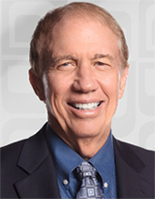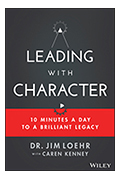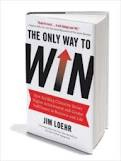Evil Part 2
Jim Loehr

The word "character" comes from the Greek word, "kharakter," a chisel or marking instrument for stone or metal. In a sense, we chisel our true essence from the bedrock of life, one moral decision at a time.
Character is who we really were when we were here. Our unique mark exists both within us and within those we lead.
Our mark, chiseled throughout our lifetime, becomes our legacy, and plays a powerful role in the legacy of all those who follow us.
To be a leader means to influence from the front, with intention. As leaders, we are culture creators. Leading with character means to create, consciously and intentionally, a culture where ethics and morality are celebrated, and given the highest priority.
Every word, every gesture, every decision forms a mark, however big or small, on our character, as well as on the culture we create around us.
The Dark Side
We have all witnessed the enormous capacity for good that human beings possess. Unfortunately, we are also painfully aware of the enormous capacity for unspeakable evil that many human beings possess.
To rally ourselves to meet the moral challenges we repeatedly face, and to understand what's at stake when we fail to rally ourselves, we need to confront the truth about our dark side.
Whenever and wherever character fails, the consequences – in business, law, politics, religion, marriage, parenting, medicine, war, you name it--can be tragic.
One of the most renowned behavioral research experiments provides us with a disturbing view into the dark side of our humanity, and what we're capable of.

Starting in 1961, Stanley Milgram, a Yale psychologist, conducted a series of tests, the results of which were published in 1963.
Milgram was interested in exploring the issue of obedience to authority. He wanted to see how easy or hard it would be for people to harm others when ordered to do so by an authority figure--and when there was no consequence to them from the individual being harmed.
Participants were instructed to administer an electric shock to a student they could see in another room, each time the student made a mistake. The co-called "idea" was to see how this might accelerate the student's learning process.
Each mistake warranted an increasing level of shock. Intensities of shock started at 15 volts and proceeded to a dangerous 450 volts. All the participants continued to administer shocks up to 300 volts, though it was within their power to refuse. Two-thirds of participants still administered shocks at 450 volts.
It so happened that no real shocks were being felt by the students. They acted as if they were being shocked. According to Milgram, almost everyone followed orders because they were given by an authority figure.
Obey

Our willingness to obey is ingrained in us from our early childhood. In the article, "The Perils of Obedience," Milgram asserted that individuals obey when they believe the authority figure will assume responsibility for the consequences of the individual's actions ("agency theory").
Milgram's experiment, with minimal variation, has been repeated across a variety of cultures, yielding more or less similar results. In some of the newer studies, obedience rates were actually higher than Milgram's.
In 2015, for example, a research team from Poland replicated Milgram's study and discovered that little had changed in the last half-century. As reported in Social Psychological and Personality Science, the researchers found that 90% of participants were willing to administer what they believed was the highest level of shock.
Milgram's research sends ominous messages. We can easily become indifferent to the suffering of others. We can be seduced into crossing critical moral lines simply by a manipulation of our external environment. Easily modified factors such as peer pressure and conformity dynamics can overwhelm our moral defenses.
In a 1939 speech, Edwin Sutherland, president of the American Sociological Society, astonished his fellow sociologists by arguing that the most serious crimes in our society were committed by well known, highly respected business leaders!

His evidence? He had studied 70 large firms over several years and found that every single one of them had at least one civil or criminal decision against it. According to his findings, 60 of the 70 firms were found guilty in criminal court, with an average of four convictions each.
In his 1949 book, White Collar Crime, Sutherland stated that seemingly ideal business leaders, as well as the large corporations they ran, were very much like professional thieves.
The question, then, is this: Who are these people who fill the business news of today and the recent past with scandals, corrupt practices, and corporate misconduct? Who are these people who fell from grace, who willfully hurt others, who bribe, embezzle, cheat, misrepresent and manipulate the truth, who defraud, who intentionally violate safety measures, and on and on and on?
According to Dean Ludwig and Clinton Longenecker, writing in the early 1990s in the Journal of Business Ethics, "The majority were of strong personal integrity and intelligence, individuals who have climbed the ladder through hard work and 'keeping their noses clean.'
But just at the moment of seemingly 'having it all,' they seemed to throw it all away by engaging in an activity which is wrong, which they knew was wrong, which 1f It would ownership of our morality requires openness to messages being if from both our rational and emotional brains.
Just as rational thinking and logical analysis are crucial components in the formation of our morality, so are feelings like compassion, kindness, and empathy. Human morality simply cannot prevail without consciousness – and neither can it prevail without the integration of reason and emotion.
When we disparage the value of our emotions, when we limit our morality to rational thinking only, owning our morality is simply not possible, because an important voice inside us has been shut down.






